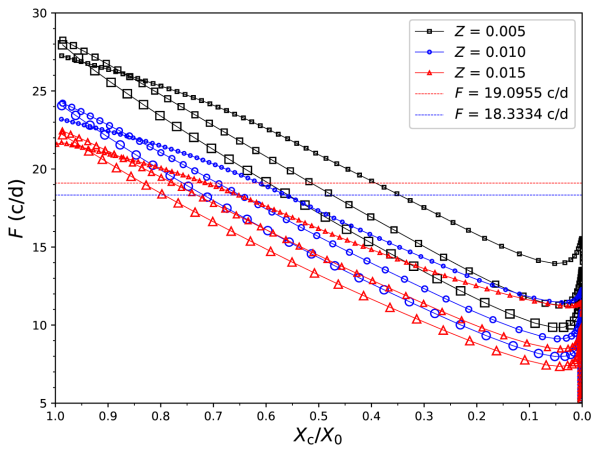In the Hertzsprung-Russel diagram, there is a subset of pulsating stars located in the overlapping region between the instability strip of δ Scuti stars and that of the γ Dor stars. Both the high-frequency p-mode manifestations of δ Scuti stars and the low-frequency g-mode oscillations of γ Doradus stars present us a compelling opportunity to investigate the structure and evolution of the star, from the envelope to the inner core.
Mode identifications are very difficult for the δ Scuti stars since the asymptotic theory is invalid due to the low radial order. Conversely, identification of the modes in the high-amplitude δ Scuti (HADS) stars is clear and straightforward, because HADS stars typically pulsate in the radial fundamental mode and/or low-overtone radial modes. Yang et al. (2021) discovered TIC308396022 to be the first HADS star with regular period spaced g modes. Such a star is very interesting since its δ Scuti-type oscillations can be easily recognized.
Based on TESS photometric data, CHEN Xinghao from Yunnan Observatories, Chinese Academy of Sciences, and his Collaborators identified TIC 65138566 and TIC 139729335 to be two other new HADS stars with equally spaced g modes. Their most prominent peaks are suggested to be the radial fundamental mode, and the KS tests revealed that their g modes exhibit equally spaced period patterns.
Through analyzing the evolutionary behaviors of the asymptotic spacing and the radial fundamental mode, they find that with increases in masses and metallicities, the star should exhibit a higher extent of evolution to match a specific period spacing. Conversely, the star should display a lower degree of evolution to match the radial fundamental mode. These two contradictory behaviors result in accurate stellar physical parameters. TIC 65138566 and TIC 139729335 are two main-sequence stars with almost the same range of masses and metallicities, while TIC 139729335 has a slightly higher hydrogen abundance and a bigger convective core.
This study was published in The Astrophysical Journal On March 8. This work is supported by the National Natural Science Foundation of China, the Yunnan Revitalization Talent Support Program Young Talent Project, the Yunnan Fundamental Research Projects, and the Youth Innovation Promotion Association of the Chinese Academy of Sciences.

Figure 1, evolution of the asymptotic period spacing Π0 from the zero-age main sequence (Xc/X0 = 1) to the terminal-age main sequence (Xc/X0 = 0). Image by CHEN.

Figure 2, evolution of the radial fundamental mode F from the zero-age main sequence (Xc/X0 = 1) to the terminal-age main sequence (Xc/X0 = 0). Image by CHEN.
Contact:
CHEN Xinghao
Yunnan Observatories, CAS
E-mail: chenxinghao@ynao.ac.cn